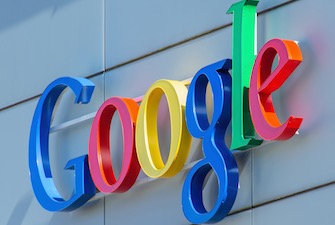 Alphabet, Inc. (NASDAQ:GOOG) of Mountain View, CA, is a multinational high tech conglomerate and the parent company for a diverse array of hardware and Internet services subsidiaries including Google, Nest and divisions in health, venture capital funding and fiber optics. Alphabet has only recently been formed from the former Google Inc. and has only reported just its latest quarterly earnings as the new corporation. Alphabet CEO Larry Page, one of the original founders of Google, made comments in early November as to Google’s recent conversion into Alphabet which explained the move as a way to reflect the reality of how the corporation was run.
Alphabet, Inc. (NASDAQ:GOOG) of Mountain View, CA, is a multinational high tech conglomerate and the parent company for a diverse array of hardware and Internet services subsidiaries including Google, Nest and divisions in health, venture capital funding and fiber optics. Alphabet has only recently been formed from the former Google Inc. and has only reported just its latest quarterly earnings as the new corporation. Alphabet CEO Larry Page, one of the original founders of Google, made comments in early November as to Google’s recent conversion into Alphabet which explained the move as a way to reflect the reality of how the corporation was run.
In recent months, Alphabet has increasingly found Facebook Inc. (NASDAQ:FB) to be a growing rival to its activities in tech development. Both of the companies have separately filed designs for drones with the Federal Aviation Administration which could be used to deliver broadband Internet services for entire cities and hover for weeks or months at elevations of 90,000 feet, much higher than commercial flight altitudes. Speculation surrounding airborne-based  Internet solutions developed by Alphabet through its Project Loon operations suggests that Alphabet could begin to threaten Facebook’s Internet.org free Internet venture in markets like India. The two companies are also expected to fare the best during the increased shift
Internet solutions developed by Alphabet through its Project Loon operations suggests that Alphabet could begin to threaten Facebook’s Internet.org free Internet venture in markets like India. The two companies are also expected to fare the best during the increased shift
in commercial brand advertising revenues from television to the Internet which is expected to accelerate during 2016.
As Google, this corporation placed sixth among all companies earning patents from the U.S. Patent and Trademark Office in 2014, receiving 2,881 U.S. patent grants that year, a 31.6 percent increase over the company’s 2013 performance. In the third quarter of this year alone, the company has already added 1,172 U.S. patents to its portfolio, according to Innography’s patent portfolio analysis tools. As the text cluster here shows, Alphabet has been placing a great deal of its research and development focus on areas like computing devices, user interfaces and search results.
Alphabet’s Issued Patents: Blind Spot Avoidance for Autonomous Vehicles and Music Selection for Exercise
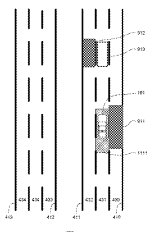 We’ve noted a larger R&D focus on automotive technologies at Alphabet over the past year and we’re not surprised to see more activity in that sector with the issue of U.S. Patent No. 9180882, which is titled Avoiding Blind Spots of Other Vehicles. The method for maneuvering a vehicle protected here involves receiving sensor data collected along a roadway, detecting objects in the roadway from the data, identifying a set of objects relevant for blind spot detection, determining a blind spot area defining a lane space adjacent to a particular identified object and maneuvering a vehicle if it’s predicted that future locations of the vehicle would be within the determined blind spot area for any object. This technology is intended to both keep drivers safe on the road as well as improving the comfort of those drivers who might not want an autonomous or semi-autonomous car driving in their blind spot.
We’ve noted a larger R&D focus on automotive technologies at Alphabet over the past year and we’re not surprised to see more activity in that sector with the issue of U.S. Patent No. 9180882, which is titled Avoiding Blind Spots of Other Vehicles. The method for maneuvering a vehicle protected here involves receiving sensor data collected along a roadway, detecting objects in the roadway from the data, identifying a set of objects relevant for blind spot detection, determining a blind spot area defining a lane space adjacent to a particular identified object and maneuvering a vehicle if it’s predicted that future locations of the vehicle would be within the determined blind spot area for any object. This technology is intended to both keep drivers safe on the road as well as improving the comfort of those drivers who might not want an autonomous or semi-autonomous car driving in their blind spot.
We were able to get a glimpse at one of Alphabet’s technologies for airborne Internet delivery with U.S. Patent No. 9174718, issued under the title Internal Toroid Balloon. It claims an apparatus having a balloon envelope fillable with a first lifting gas, a top plate arranged at the top of the balloon envelope, an outlet port providing a passageway from inside the balloon envelope into the atmosphere and an inner bladder positioned within the balloon envelope coupled to the top plate and fillable with a second lifting gas. The use of the inner bladder coupled to the top plate is intended to provide drag to a balloon as lifting gas is vented, slowing the descent of the balloon to the ground.
Alphabet has been making forays into home appliance technologies ever since Google’s acquisition of Nest and we’re seeing an intriguing device at the center of U.S. Patent No. 9183736, titled Smart-Home Hazard Detector Providing Sensor-Based Device Positioning Guidance. It discloses a method of receiving sensor or feature readings representative of a position and orientation of a hazard detector as placed to a surface in a structure, determining that the hazard detector is in an inadvisable position and/or orientation and generating a signal representative of a user-perceptible cue to indicate that the hazard detector is in an inadvisable position and/or orientation. The smart hazard detector of this invention offers installation guide features so that users properly install a device like a fire alarm in an appropriate space.
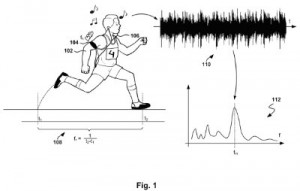 We also noted an innovation in music software designed with health and fitness implications, featured within U.S. Patent No. 9183822, titled Music Selection and Adaptation for Exercising. It protects a method for providing music while exercising by detecting the pace of exercising, selecting a music segment based on the pace, modifying the music segment to correlate a tempo of the segment to a pace of exercising, introducing a delay in the modified music segment to cycles of the pace of exercising and playing the modified music segment in one or more speakers. This system is designed to automatically provide the right music for the pace of a user’s exercise, which is desirable to many runners and athletes.
We also noted an innovation in music software designed with health and fitness implications, featured within U.S. Patent No. 9183822, titled Music Selection and Adaptation for Exercising. It protects a method for providing music while exercising by detecting the pace of exercising, selecting a music segment based on the pace, modifying the music segment to correlate a tempo of the segment to a pace of exercising, introducing a delay in the modified music segment to cycles of the pace of exercising and playing the modified music segment in one or more speakers. This system is designed to automatically provide the right music for the pace of a user’s exercise, which is desirable to many runners and athletes.
 Google’s even making developments in disposable cameras which is reflected by the issue of U.S. Patent No. 9168761, titled Disposable Digital Camera with Printing Assembly. It claims a digital camera having an image capture assembly, a print media transport assembly, a pagewidth ink jet printhead, a roll of print media, an internal chassis serving as a frame for the other components and an external casing containing all of the components and openable. This invention provides a disposable camera which can be produced in an inexpensive way so as to capitalize on growing consumer demand for disposable cameras.
Google’s even making developments in disposable cameras which is reflected by the issue of U.S. Patent No. 9168761, titled Disposable Digital Camera with Printing Assembly. It claims a digital camera having an image capture assembly, a print media transport assembly, a pagewidth ink jet printhead, a roll of print media, an internal chassis serving as a frame for the other components and an external casing containing all of the components and openable. This invention provides a disposable camera which can be produced in an inexpensive way so as to capitalize on growing consumer demand for disposable cameras.
A software engineering technology useful for helping programmers identify where code failures exist is described by U.S. Patent No. 9176731, which is titled Heuristics for Automated Culprit Finding. The system for isolating one or more code changes suspected of causing a code failure in a codebase described here involves processing devices and storage devices having a memory executable to receive a list of changes to a codebase, receive a list of test targets in the codebase that are failing, receive a snapshot of the codebase when the tests started failing, use a compile or execution log to find the code changes causing test failures and determine whether the test failure was caused by an execution failure. This innovation is intended to reduce the amount of time consumed in manual investigations of failed code tests used to find code changes which have caused test failures.
Patent Applications of Note: From Email Shopping to Digital Rendering of Painting Styles
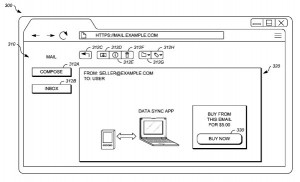 Digital wallet and e-commerce technologies have been very active areas of high tech R&D in recent months and we’re seeing Alphabet trying to add to its IP portfolio in this area with U.S. Patent Application No. 20150304250, which is titled Online Shopping in Email Messages. This would protect a method comprising receiving an email message addressed to a user from a seller, outputting at a device an email interface screen having an operable interface element for ordering goods or services, receiving information indicating operation of the interface element and transmitting a purchase request relating to the goods or services. This technology is designed to improve email marketing campaigns by obviating the need for a consumer to complete an order at a merchant’s website. Increased security when conducting financial transactions is at the center of U.S. Patent Applications No. 20150302412, filed under the title Online Bank Transfer Transactions. It discloses a computer-implemented method to use credit authorizations to guarantee alternate reimbursement from a user for a bank transfer transaction, the method involving establishing a user record including financial account information and credit card information, receiving a request for authorization for a transaction conducted between a user and a merchant system, transmitting a credit authorization request including a request to approve a charge to a credit account, receiving a credit authorization approval associated with the request, transmitting a bank transfer request and transferring funds in the amount of the transaction authorization request. This invention is designed to improve security for online transactions by providing merchants with assurances that a transaction will be approved.
Digital wallet and e-commerce technologies have been very active areas of high tech R&D in recent months and we’re seeing Alphabet trying to add to its IP portfolio in this area with U.S. Patent Application No. 20150304250, which is titled Online Shopping in Email Messages. This would protect a method comprising receiving an email message addressed to a user from a seller, outputting at a device an email interface screen having an operable interface element for ordering goods or services, receiving information indicating operation of the interface element and transmitting a purchase request relating to the goods or services. This technology is designed to improve email marketing campaigns by obviating the need for a consumer to complete an order at a merchant’s website. Increased security when conducting financial transactions is at the center of U.S. Patent Applications No. 20150302412, filed under the title Online Bank Transfer Transactions. It discloses a computer-implemented method to use credit authorizations to guarantee alternate reimbursement from a user for a bank transfer transaction, the method involving establishing a user record including financial account information and credit card information, receiving a request for authorization for a transaction conducted between a user and a merchant system, transmitting a credit authorization request including a request to approve a charge to a credit account, receiving a credit authorization approval associated with the request, transmitting a bank transfer request and transferring funds in the amount of the transaction authorization request. This invention is designed to improve security for online transactions by providing merchants with assurances that a transaction will be approved.
Autonomous vehicle development continues at Google as we can see within U.S. Patent Application No. 20150284009, titled Engaging and Disengaging for Autonomous Driving. The method disclosed here involves receiving a request to switch a vehicle from a manual driving mode to an autonomous driving mode, using protocol data to assess the vehicle’s environment, vehicle systems and a user, selecting a set of driving conditions based on the assessment, generating a set of tasks based on the driving conditions that may be performed by a driver to change a condition, selecting a first task based on task priority, reassessing task priority when a first task has been completed and switching the vehicle’s driving mode when all tasks are completed. This technique is capable of determining whether a car should remain in a manual driving mode in response to weather or other driving conditions.
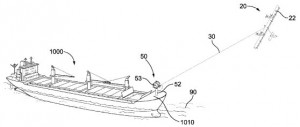 We were interested to explore an energy generation technology meant for shipping applications and detailed within U.S. Patent Application No. 20150298806, title Airborne Rigid Kite with On-Board Power Plant for Ship Propulsion. It would protect a vehicle-based airborne wind turbine system having an aerial wing and a plurality of rotors each having rotatable blades positioned on the aerial wing, an electrically conductive tether; the aerial wing is adapted to receive electrical power for the vehicle to provide propelling thrust to pull a vehicle. The aerial wing may receive electric power from a submerged ship or generate energy from wind sources in order to reduce fuel consumed by underwater propellers.
We were interested to explore an energy generation technology meant for shipping applications and detailed within U.S. Patent Application No. 20150298806, title Airborne Rigid Kite with On-Board Power Plant for Ship Propulsion. It would protect a vehicle-based airborne wind turbine system having an aerial wing and a plurality of rotors each having rotatable blades positioned on the aerial wing, an electrically conductive tether; the aerial wing is adapted to receive electrical power for the vehicle to provide propelling thrust to pull a vehicle. The aerial wing may receive electric power from a submerged ship or generate energy from wind sources in order to reduce fuel consumed by underwater propellers.
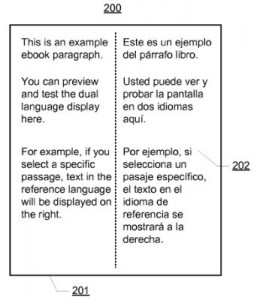 Innovations targeting digital text-based files were featured within a couple of patent applications which we noted, including U.S. Patent Application No. 20150324073, entitled Displaying Aligned Ebook Text in Different Languages. This discloses a method of providing a reference passage corresponding to a reading passage of an ebook by grouping different-language instances of a same ebook into a group, aligning corresponding passages of the different-language instances of the ebook in a group, identifying a reference passage in a reference-language instance of the ebook aligned with the reading passage and sending information describing the identified reference passage in response to the request. This system is designed to provide text translations in ebooks which are more accurate than typical machine-translated text. A system for measuring the accuracy of factual information found in search results is at the center of U.S. Patent Application No. 20150317367, which is titled Corroborating Facts in Electronic Documents. It claims a computer-implemented method for identifying facts described by electronic documents; the method includes defining a query, creating one or more hypothetical facts in response to the query, corroborating hypothetical facts using the electronic documents to identify a likely correct fact and presenting the identified likely correct fact as the answer to the query. This invention, intended for use in fact databases, is designed to limit contradictory or ambiguous answers from search engine results.
Innovations targeting digital text-based files were featured within a couple of patent applications which we noted, including U.S. Patent Application No. 20150324073, entitled Displaying Aligned Ebook Text in Different Languages. This discloses a method of providing a reference passage corresponding to a reading passage of an ebook by grouping different-language instances of a same ebook into a group, aligning corresponding passages of the different-language instances of the ebook in a group, identifying a reference passage in a reference-language instance of the ebook aligned with the reading passage and sending information describing the identified reference passage in response to the request. This system is designed to provide text translations in ebooks which are more accurate than typical machine-translated text. A system for measuring the accuracy of factual information found in search results is at the center of U.S. Patent Application No. 20150317367, which is titled Corroborating Facts in Electronic Documents. It claims a computer-implemented method for identifying facts described by electronic documents; the method includes defining a query, creating one or more hypothetical facts in response to the query, corroborating hypothetical facts using the electronic documents to identify a likely correct fact and presenting the identified likely correct fact as the answer to the query. This invention, intended for use in fact databases, is designed to limit contradictory or ambiguous answers from search engine results.
Finally, we wanted to profile a novel technology useful for the digital rendering of painting styles which is the focus of U.S. Patent Application No. 20150310305, titled Learning Painting Styles for Painterly Rendering. This patent application would protect a computer-implemented method of rendering a base output image based on a received input image with a procedural painting system controlled by parameters, using a classifier trained to calculate a score based on how an image corresponds to a received painting style, determining a plurality of randomized sets of meta-parameters for the procedural painting system, rendering a plurality of intermediate output images by the procedural painting system, calculating a score for each intermediate output image using the trained classifier and identifying an optimal set of meta-parameters based on the calculated scores. This innovation is intended to automatically generate an image imitating a painting style based on an input image, without requiring the human user to create an algorithm for rendering the image in a preferred painting style.

![[IPWatchdog Logo]](https://ipwatchdog.com/wp-content/themes/IPWatchdog%20-%202023/assets/images/temp/logo-small@2x.png)

![[[Advertisement]]](https://ipwatchdog.com/wp-content/uploads/2023/01/2021-Patent-Practice-on-Demand-1.png)
![[Advertisement]](https://ipwatchdog.com/wp-content/uploads/2024/04/Patent-Litigation-Masters-2024-sidebar-early-bird-ends-Apr-21-last-chance-700x500-1.jpg)

![[Advertisement]](https://ipwatchdog.com/wp-content/uploads/2021/12/WEBINAR-336-x-280-px.png)
![[Advertisement]](https://ipwatchdog.com/wp-content/uploads/2021/12/2021-Patent-Practice-on-Demand-recorded-Feb-2021-336-x-280.jpg)
![[Advertisement]](https://ipwatchdog.com/wp-content/uploads/2021/12/Ad-4-The-Invent-Patent-System™.png)







Join the Discussion
One comment so far.
Curious
November 23, 2015 09:52 amDigital wallet and e-commerce technologies
LOL — you mean “abstract ideas” if somebody else gets a patent on them. Of course, if Google gets a patent on them, well, that is a different story.